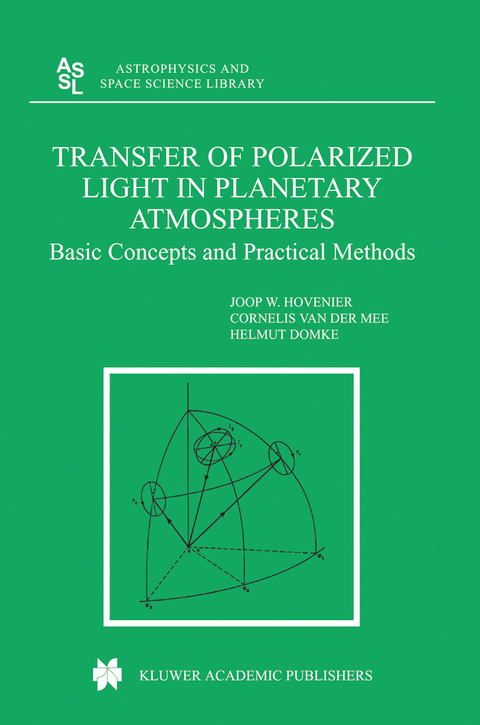
Transfer of Polarized Light in Planetary Atmospheres
Basic Concepts and Practical Methods
Seiten
2014
|
Softcover reprint of the original 1st ed. 2004
Springer-Verlag New York Inc.
978-1-4020-2889-2 (ISBN)
Springer-Verlag New York Inc.
978-1-4020-2889-2 (ISBN)
The principal elements of the theory of polarized light transfer in planetary atmospheres are expounded in a systematic but concise way. Basic concepts and practical methods are emphasized, both for single and multiple scattering of electromagnetic radiation by molecules and particles in the atmospheres of planets in the Solar System, including the Earth, and beyond. A large part of the book is also useful for studies of light scattering by particles in comets, the interplanetary and interstellar medium, circumstellar disks, reflection nebulae, water bodies like oceans and suspensions of particles in a gas or liquid in the laboratory.
Throughout the book symmetry principles, such as the reciprocity principle and the mirror symmetry principle, are employed. In this way the theory is made more transparent and easier to understand than in most papers on the subject. In addition, significant computational reductions, resulting from symmetry principles, are presented. Hundreds of references to relevant literature are given at the end of the book. Appendices contain supplementary information such as a general exposition on properties of matrices transforming Stokes parameters of light beams. Each chapter concludes with a number of problems with answers or hints for solution.
The readers should have some basic knowledge of physics and mathematics. The book is suitable as a textbook for advanced undergraduates and graduate students. It will also be of interest to science professionals in one of the many disciplines in which electromagnetic scattering plays an important role, like astrophysics, atmospheric optics, remote sensing, marine optics, biophysics and biomedicine.
Throughout the book symmetry principles, such as the reciprocity principle and the mirror symmetry principle, are employed. In this way the theory is made more transparent and easier to understand than in most papers on the subject. In addition, significant computational reductions, resulting from symmetry principles, are presented. Hundreds of references to relevant literature are given at the end of the book. Appendices contain supplementary information such as a general exposition on properties of matrices transforming Stokes parameters of light beams. Each chapter concludes with a number of problems with answers or hints for solution.
The readers should have some basic knowledge of physics and mathematics. The book is suitable as a textbook for advanced undergraduates and graduate students. It will also be of interest to science professionals in one of the many disciplines in which electromagnetic scattering plays an important role, like astrophysics, atmospheric optics, remote sensing, marine optics, biophysics and biomedicine.
From the contents: Preface.- 1. Description of Polarized Light.- 2. Single Scattering.- 3. Plane-parallel Media.- 4. Orders of Scattering and Multiple-Scattering Matrices.- 5. The Adding-doubling Method.- A. Mueller Calculus.- B. Generalized Spherical Functions.- C. Expanding the Elements of F (T).- D. Size Distributions.- E. Proofs of Relationships for Multiple-Scattering Matrices.- F. Supermatrices and Extended Supermatrices.- Bibliography.- Index.
| Reihe/Serie | Astrophysics and Space Science Library ; 318 |
|---|---|
| Zusatzinfo | XIV, 258 p. |
| Verlagsort | New York, NY |
| Sprache | englisch |
| Maße | 170 x 244 mm |
| Themenwelt | Naturwissenschaften ► Physik / Astronomie ► Angewandte Physik |
| Naturwissenschaften ► Physik / Astronomie ► Astronomie / Astrophysik | |
| Naturwissenschaften ► Physik / Astronomie ► Optik | |
| Technik ► Luft- / Raumfahrttechnik | |
| ISBN-10 | 1-4020-2889-X / 140202889X |
| ISBN-13 | 978-1-4020-2889-2 / 9781402028892 |
| Zustand | Neuware |
| Informationen gemäß Produktsicherheitsverordnung (GPSR) | |
| Haben Sie eine Frage zum Produkt? |
Mehr entdecken
aus dem Bereich
aus dem Bereich


